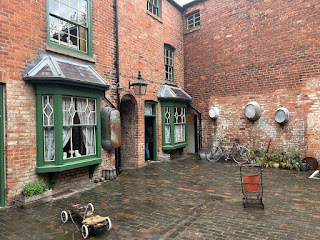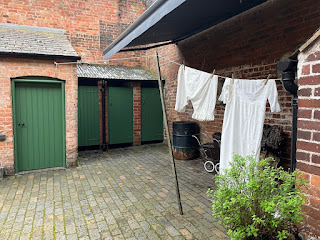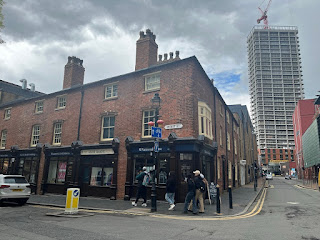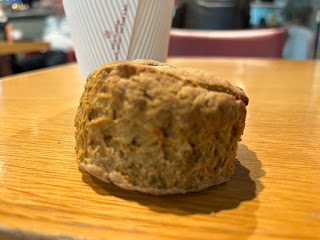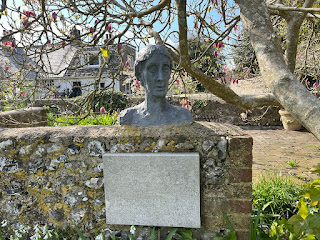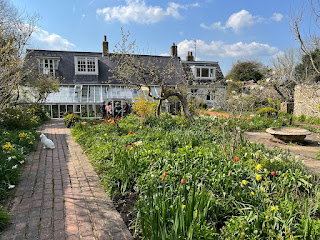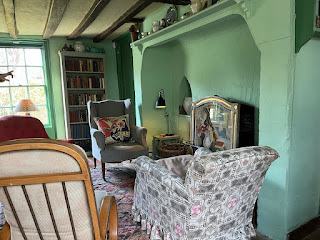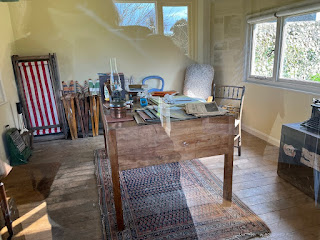And so we come to the final National Trust scone of this project. After almost 10 years, 243 NT properties, thousands of miles, and more scones, jam and cream than I can even contemplate, I completed my quest by going to the only NT cafe that I hadn't already covered on this blog.
I left the Giant's Causeway til last for three reasons. Firstly, I wanted to be sure of getting a scone on my final mission. I've only actually ever had a few scone no-shows, but I couldn't risk it happening at the grand finale. Before the pandemic, the Giant's Causeway was attracting over 700,000 visitors a year and it has a big, modern visitor centre and cafeteria - I figured this would give me the best possible chance of success.
Secondly, I'd started this project with my husband, Pete (aka the Scone Sidekick). We'd visited a lot of NT properties together before I lost him to cancer in 2018. But we'd also been to the Giant's Causeway in 2006, long before we'd joined the National Trust. So although I knew he couldn't be physically present for this last mission, I knew he'd been there and seen it and loved it.
And then, finally, I chose the Giant's Causeway as it's the only National Trust property that looks like it's MADE out of scones:
I might as well break it to you now, though, that the Giant's Causeway is not made of scones. Here's some background:
The story of Finn McCool and the Giant's Causeway
My interest in the Giant's Causeway started at primary school. Our head teacher used to tell us the story of how Finn McCool, the Irish giant, had built the causeway so he could challenge the Scottish giant, Benandonner, to a fight. One day Finn saw Benandonner coming over the stones and was shocked at how big he was. He rushed home to his wife, Oonagh, who came up with a plan: Finn dressed up as a baby and climbed into the child's cot. When Benandonner knocked on the door, Oonagh told him Finn was out but he was welcome to wait. Benandonner saw the size of the baby and took fright, wondering how big Finn must be. He rushed back home across the causeway, pulling it up as he went so Finn couldn't follow him.
As with all good stories, there are numerous spin-offs. The 'camel' below was pointed out by our guide. Finn used it when he needed to get around in a hurry, apparently:
The story of Finn McCool and the Giant's Causeway became properly world-famous when tourists started visiting the area. However, Finn McCool (or Fionn mac Cumhaill to use his proper Irish name) was a mythical hero whose many other adventures were documented in the 12th century.
It was actually formed by lava flows 60 million years ago
Much as I'd love to stick with the scone or giant theories, the columns at the Giant's Causeway are actually made of basalt, which is a fine-grained rock formed by the rapid cooling of lava. 60 million years ago, lava spilled over what is now County Antrim as a result of tectonic plates moving around. The lava was cooled by the sea and the air, which caused it to split and form hexagonal columns.
The Giant's Causeway is (almost) unique
There are other rock columns around the world - Fingal's Cave on the Isle of Staffa in Scotland for example (which is also named after Finn McCool), or Los Organos in the Canary Islands. But our guide explained that whereas many of these other columns are topped with a layer of rock, at the Giants Causeway that layer of rock was knocked off during the Ice Age. This means that the tops of the columns are exposed and you can walk on them, which makes them special.

It's been a tourist destination since the 18th century
The Royal Society in London started taking an interest in the Giant's Causeway in 1688 and its origins were much debated during the Age of Enlightenment (1620s-1780s). An artist called Susanna Drury painted two famous pictures of the Causeway in 1739-40 and those paintings were scrutinised across Europe. The Vulcanists believed that the stones came from the earth, while the Neptunists thought they came from the sea. The area also attracted writers, artists and other tourists as well as scientists. The author Thackeray paid to join a boat trip and see the rocks from the sea, writing: "I paid ten shillings for mine, and ten minutes before would cheerfully have paid five full pounds to be allowed to quit it."
The Giant's Causeway Scone
I must have either been very optimistic or deranged by stress on this trip, because I broke my usual rule of 'scone first'. I've always been paranoid that a plague of scone-loving locusts will descend on the tea room while I'm walking around a property. But today I waited until after we'd done our tour, and by the time I got to the cafe my stress levels were through the roof.
The relief of finding a scone - and there was a choice of plain, fruit or cheese - was enormous. They only had whipped cream rather than clotted, but this is a scone blog and not a cream tea blog so it didn't really matter.
Strangely, one thing I wasn't worried about at all was the quality of the scone. I had decided that as long as I got a scone, I could cope with it not being excellent. But it was excellent. It was very fresh and fluffy with a good amount of fruit. In a world first, I even went back the following day - and the second scone was excellent as well. Consistency abounds at the Giant's Causeway.
With the quest complete, we got back in the car and headed off to nearby Mussenden Temple and Portstewart Strand - both NT properties without scones that I hadn't been to before. I hadn't really given much thought to what would happen at the end of the project. I'd hoped I might get a round of applause from the brilliant people on Twitter that had been following the project - and I did, which was lovely.
A nice man from the Press Association had been keeping tabs on my progress in recent months and I did an interview with them that night. I know enough about the Press Association to know that these things often come to nothing, so I was delighted in the morning when they texted me a link to an article that had appeared in the Independent. Then I started to get texts from friends saying they'd seen it on the BBC. And then everything went absolutely crazy: I was invited on Five Live Drive, Radio 4 The World Tonight, and Radio Ulster amongst others. I was also interviewed by the Telegraph. The following day it was everywhere. Over the next week I was on BBC Breakfast, This Morning with Holly and Phil, and the Jeremy Vine show on Radio 2. Even the Washington Post covered it.
The huge amount of media coverage delivered a completely unexpected bonus: it was like Pete came back for a week. Seeing his picture on TV and in the papers felt completely right - he had also put a lot of miles into this project and now here he was at the end getting the attention he deserved. It was so totally unexpected and I literally could not have asked for anything nicer.
 |
| Pete at the Giant's Causeway in 2006 |
So what's next? I'll definitely continue to add to this blog. I might go north of the border and try out some National Trust of Scotland scones. There are also lots of other National Trust properties in England, Wales and Northern Ireland that might not serve scones but deserve a mention. So you haven't heard the last of me.
Finally, I need to say THANK YOU. To all of the Sconepals on social media that have shared photos, encouragement and amusement. To all of the scone fans that I got to meet in person - especially Natalie, Abby, Helen, Corinne, Simon and the marvellous Ole. To the National Trust employees that I got to meet in person along the way (there weren't many as I kept a low profile), especially Jemma, Russell, Sarah, Sarah, Rob, Clive, Karla, Devon. To everyone that has read this blog. Most of all, my thanks go to my brilliant friends and family who have given up days, weekends, even weeks to join me on scone missions - Thelma, Fay, Pam, SJ, Steph, Hilary, John, Sarah, Lara, Kathy, Justin, Olivia, Amy, Lisa, Amalia, John, Justine, Tracey, Tim, my brilliant mum, and, of course, Pete the original Scone Sidekick. Thank you all, from the bottom of my heart.
Giant's Causeway: 5 out of 5
Scones: 5 out of 5
Consistency of scone quality: 5 out of 5





